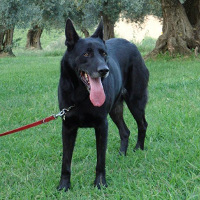 |
Cane da Pastore Italiano |
|
He is not recognized by the F.C.I. |
Origin |
Italy | |
Translation |
Francis Vandersteen |
Usage |
| A member of the sheepdog group (group 1), it is used as a guard, defense and utility dog. |
Brief historical summary |
| The history of the Italian Sheepdog began around 1975, when Piero Accettella (Little Ranch Cepagatti Kennel - Pescara) noted that in Italy, particularly in the regions of Abruzzo, Marche, northern Lazio, Tuscany and Umbria, there were black-coated, medium-sized dogs with lupoid features, used for breeding, endowed with vivacious intelligence and great psychological balance, whose origins are lost in the mists of time. After meticulous research, he managed to capture some interesting subjects and, to give them a more imposing size, he inserted Molossian blood from Abruzzo. The result is very interesting, because psychologically, to the flexibility of the basic strain, he manages to combine the right Abruzzese mistrust, to obtain a very balanced dog, for all types of training, but also a tenacious guard dog. |
General appearance |
| Harmonious in constitution. A medium-sized dog with a harmonious constitution. Despite its bulk, this dog is very agile and powerful, a tireless trotter, constantly patrolling the territory to defend it. Very hardy, adult at four years of age, it has an iron constitution and a very long lifespan averaging 17 years. |
Behaviour / temperament |
| Very serious and well-balanced, never attacks without reason, exceptional guardian, suspicious and biting towards strangers on its territory, indifferent and unchanging outside its environment (always close to its master). This hardy dog needs a determined owner. It adapts to any climate and master who loves it unconditionally to the point of madness. Physically, the Italian Shepherd is a truly unique dog. It is a wolf with erect ears, with the characteristic tip that tends to curve slightly inwards. The body is long, with a powerful back, and the trunk is 30% longer than it is tall. Another distinctive feature is the slow growth rate, in fact, maturation occurs around the age of four. This is a very lively dog, as it lives an average of 17 years. He's healthy as a horse, hardy and natural. His characters are now fixed. The breed has reached the third generation and good homogeneity can be observed. |
Head |
||
Cranial region |
||
Skull |
Large skull. | |
Facial region |
||
Muzzle |
Square muzzle, generally well proportioned. | |
Eyes |
Round, brown eyes, more or less dark. Highly expressive, the gaze changes according to the situation, requiring either aggression or gentleness. | |
Ears |
Ears set high, large, erect, with tips set back, (defined around 8/12 months, they are neither cropped nor handled). | |
Neck |
| Short, muscular neck. |
Body |
||
Body |
Long, horizontal trunk, set in a rectangle. The length of the trunk is about 30% of the height. | |
Tail |
| Long, set high (preferably hanging). |
Limbs |
Forequarters |
||
Generality |
Strong, well developed and sloping, straight and far apart. | |
Hindquarters |
||
Generality |
Muscular, powerful thighs, slightly sloping, strong hocks. | |
Feet |
| Open and webbed. |
Coat |
||
Hair |
Short to medium length, with dense undercoat. | |
Colour |
Color : black, beige, cream or black mantle with shades (all colors permitted), white chest patch tolerated. Nose, gums, fingertips and nails are black. | |
Size and weight |
||
Height at withers |
Males : 62-70 cm at withers, females : 55-56 cm at withers. | |
Weight |
Males : approx. 35-45 kg, females : approx. 25-35 kg. | |
Faults |
| • Any departure from the foregoing points should be considered a fault and the seriousness with which the fault should be regarded should be in exact proportion to its degree and its effect upon the health and welfare of the dog and its ability to perform its traditional work. • Faults listed should be in degree of seriousness. |
General faults |
 Low croup. Low croup. Short trunk. Short trunk. Narrow muzzle. Narrow muzzle. Prognathism and enognatism. Prognathism and enognatism. Hind spurs. Hind spurs. Lack of restraint. Lack of restraint. |
NB : |
| • Any dog clearly showing physical or behavioural abnormalities shall be disqualified. • The above mentioned faults when occurring to a highly marked degree or frequently are disqualifying. • Male animals should have two apparently normal testicles fully descended into the scrotum. • Only functionally and clinically healthy dogs, with breed typical conformation should be used for breeding. |






 English (United Kingdom)
English (United Kingdom)